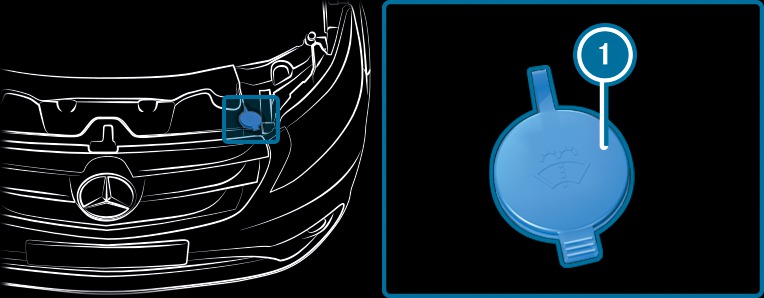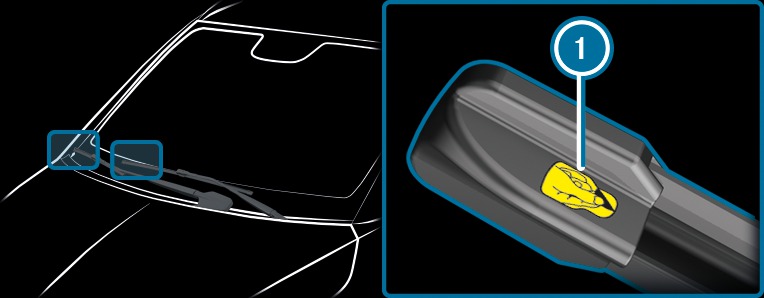Damaged tyres can cause tyre pressure loss.
As a result, you could lose control of your vehicle.
Check the wheels and tyres of your vehicle for damage regularly, i.e. at least every two weeks, as well as after driving off-road or on rough roads. Damaged wheels can lead to a loss of tyre pressure.
cuts in the tyres
punctures in the tyres
tears in the tyres
bulges on tyres
deformation or severe corrosion on wheels
Insufficient tyre tread will result in reduced tyre grip. The tyre tread is no longer able to dissipate water.
This means that in heavy rain or slush the risk of aquaplaning is increased, in particular where speed is not adapted to suit the conditions.
If the tyre pressure is too high or too low, tyres may exhibit different levels of wear at different locations on the tyre tread.
Summer tyres: 3 mm
M+S tyres: 4 mm
check the tyre pressure More
check the valve caps
Valves must be protected from moisture and dirt with valve caps specifically approved by Mercedes-Benz for your vehicle.
visually inspect the tread depth and the tyre tread across the whole tyre width
For summer tyres, the minimum tread depth is 3 mm and for winter tyres 4 mm.
For safety reasons, Mercedes-Benz recommends that you only use snow chains that have been checked and approved. You can find further information on snow chains recommended for Mercedes-Benz in the wheel and tyre overview at Homepage Mercedes-Benz.
If snow chains are fitted to steel wheels, the wheel trims can be damaged.
Snow chains are only permissible for certain wheel/tyre combinations. You can obtain information on them at a qualified specialist workshop.
For safety reasons, only use snow chains that have been specifically approved for your vehicle by Mercedes-Benz , or snow chains with the same quality standard.
The snow chains must be retightened after driving approximately 1 km. This is the only way to ensure the snow chains are optimally seated with clearance to adjacent components.
Use snow chains only when the road surface is completely snow-covered. Remove the snow chains as soon as possible when you come to a road that is not snow-covered.
Local regulations may restrict the use of snow chains. Observe the applicable regulations before fitting snow chains.
If snow chains are fitted, the maximum permissible speed is 50 km/h.
Observe the notes on operating fluids More.
Windscreen washer concentrate is highly flammable. It could ignite if it comes into contact with hot engine component parts or the exhaust system.
Unsuitable windscreen washer fluids may damage the plastic surface of the exterior lighting.
Do not use distilled or de-ionised water. Otherwise, the fill level sensor may give a false reading.
Above freezing point: e.g. MB SummerFit
Below freezing point: e.g. MB WinterFit
For the correct mixing ratio, refer to the information on the anti-freeze container.
Mix the washer fluid with windscreen washer fluid all year round.
If you open the engine bonnet when the engine has overheated or during a fire in the engine compartment, you could come into contact with hot gases or other escaping operating fluids.
Components in the engine compartment may continue running or start up suddenly, even if the ignition is switched off.
Make sure of the following before performing tasks in the engine compartment:
Windscreen washer concentrate is highly flammable.
Certain components in the engine compartment can be very hot, e.g. the engine, the radiator and parts of the exhaust system.
bonnet
dipstick
engine oil filler opening cap
washer fluid reservoir cap
coolant expansion reservoir cap
Unsuitable windscreen washer fluids may damage the plastic surface of the exterior lighting.

 of the washer fluid reservoir upwards by the tab.
of the washer fluid reservoir upwards by the tab.  onto the filler opening until it audibly engages.
onto the filler opening until it audibly engages. Mix the washer fluid with windscreen washer concentrate all year round. Observe the further information on windscreen washer fluid under "Operating fluids and capacities" More.
If the windscreen wipers begin to move while you are changing the wiper blades, you can be trapped by the wiper arm.
If the wiper arm on the windscreen or rear window is folded back before a wiper blade has been fitted, the window may be damaged by the force of the impact.
If the windscreen wipers have been folded back from the windscreen when the bonnet is opened, the windscreen wipers or the bonnet may be damaged.

 away from the wiper arm as far as it will go.
away from the wiper arm as far as it will go.  in the direction of arrow
in the direction of arrow  until it engages in the removal position.
until it engages in the removal position.  .
. 
 .
.  in the direction of arrow
in the direction of arrow  until it engages in the locking position.
until it engages in the locking position. 
 from the maintenance displays on the tips of the newly fitted wiper blades.
from the maintenance displays on the tips of the newly fitted wiper blades. If the colour of the maintenance display changes from black to yellow, the wiper blades should be replaced.
The time until the colour changes varies depending on the usage conditions.

